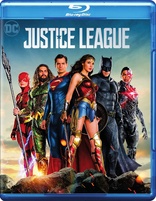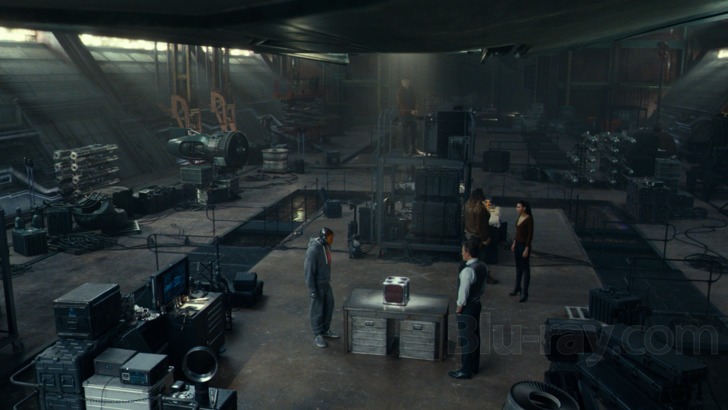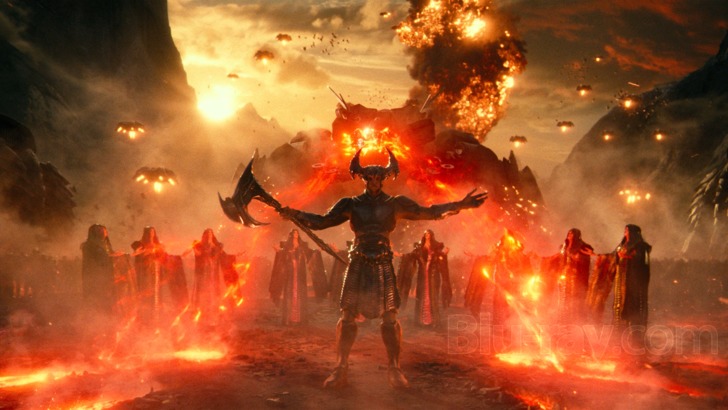Justice League Blu-ray Movie
HomeJustice League Blu-ray Movie 
Blu-ray + DVD + UV Digital CopyWarner Bros. | 2017 | 120 min | Rated PG-13 | Mar 13, 2018

Movie rating
6.4 | / 10 |
Blu-ray rating
| Users | 3.0 | |
| Reviewer | 3.0 | |
| Overall | 3.0 |
Overview
Justice League (2017)
Earth's greatest heroes are assembled to form the Justice League, to combat a threat beyond each member's capabilities.
Starring: Ben Affleck, Henry Cavill, Amy Adams, Gal Gadot, Ezra MillerDirector: Zack Snyder, Joss Whedon
| Action | Uncertain |
| Adventure | Uncertain |
| Comic book | Uncertain |
| Fantasy | Uncertain |
Specifications
Video
Video codec: MPEG-4 AVC
Video resolution: 1080p
Aspect ratio: 1.78:1
Original aspect ratio: 1.85:1
Audio
English: Dolby Atmos
English: Dolby TrueHD 7.1 (48kHz, 24-bit)
English: DTS-HD Master Audio 5.1 (48kHz, 24-bit)
French (Canada): Dolby Digital 5.1
Spanish: Dolby Digital 5.1 (448 kbps)
Portuguese: Dolby Digital 5.1
English: Dolby Digital 5.1 (448 kbps)
English DD=narrative descriptive
Subtitles
English SDH, French, Portuguese, Spanish
Discs
Blu-ray Disc
Two-disc set (1 BD, 1 DVD)
UV digital copy
DVD copy
Packaging
Slipcover in original pressing
Playback
Region A (B, C untested)
Review
Rating summary
| Movie | 2.5 | |
| Video | 4.0 | |
| Audio | 4.0 | |
| Extras | 2.5 | |
| Overall | 3.0 |
Justice League Blu-ray Movie Review
The League of Extraordinary Franchise Builders
Reviewed by Michael Reuben March 12, 2018Have you ever experienced a form of cinematic déjà vu in which you're watching a brand new
movie but you're certain you've already seen it? That's what I felt watching Justice League, the
latest effort by Warner Brothers to revitalize their DC Comics franchise on the big screen. (With
TV series, they're doing just fine, thank you.) After months of relentless promotion and
numerous trailers showcasing many of the film's biggest moments and quippiest exchanges, I sat
waiting for something new and surprising—and the wait continues. When a superhero
extravaganza's biggest claim to novelty is a musical shout-out to a thirty-year-old
predecessor—I'm referring, of course, to Danny Elfman's sampling of his score for Tim Burton's
1989 Batman—the project is in
trouble, especially given its
reported production cost of $300
million. As of the most recent account, JL has yet to recoup its investment, despite a
worldwide box office of $658 million.
By now, most fans know that JL was reshaped from director and co-writer
Zack Snyder's original conception, with two months of reshoots overseen by Avengers director Joss Whedon. One can only guess what the film would have been if Snyder
hadn't left the project
after principal photography because of a family tragedy. Whedon, who receives a writing credit
on JL, clearly made major changes, not the least of which was bringing in Elfman to replace
Batman v.
Superman's Junkie XL. The film's cinematographer, Fabian Wagner, has confirmed
that substantial scenes he shot with Snyder were left on the cutting room floor, including one
prominently featured in a widely seen trailer where Batman's loyal butler, Alfred, greets an off-screen presence who can only
be—spoiler alert!—a
revivified Superman. (Seriously: Is there
anyone who doesn't know that Superman is reborn in JL?) The scene was clearly designed as a
grand entrance for the Man of Steel, but if you're one of the millions who saw it in the trailer,
don't watch JL waiting for it. The annunciation promised in the trailer, with its crescendo of
vibrations and a look of wondrous relief on Alfred's face, has been replaced by something quick
and jokey.
The new version of Superman's return works just fine, but it's only one of the many obvious examples of two
storytelling styles fighting for dominance throughout JL, as the trademark grandiosity that Snyder
brought to the DC franchise with Man of Steel
and Batman v.
Superman is repeatedly tamped
down by a kind of disciplined narrative craftsmanship that Snyder has never cared about. It's an
odd mix, resulting in a generic blandness that all the CG wizardry in the world can't spice up. (Some of the continuity problems created by the
reshoots have been catalogued by my colleague Josh Katz, to whose weekly column I
refer the curious reader.)

The best description of JL I know came from a friend of mine, a dedicated movie fan, who, after watching the film's trailers, decided not to see it. When I asked him why, his answer came down to one word: predictability. He then proceeded to offer a succinct plot summary that was remarkably accurate for someone who hadn't watched the film:
Some incident will bring all of the members together, they'll be apprehensive about working with one another, some of them will dislike one another, they'll have a big baddy that they'll initially fail against, they'll be discouraged, they'll learn how to fight as a team, they'll win, and everyone lives happily ever after.
That's it in a nutshell, as Batman (Ben Affleck), Wonder Woman (Gal Gadot), Superman (Henry Cavill), the Flash (Ezra Miller), Aquaman (Jason Momoa) and Cyborg (Ray Fisher) unite to defeat a world-destroying alien known as Steppenwolf (a CG creation voiced by Ciarán Hinds), whose abbreviated back story is hurriedly supplied by Wonder Woman in voiceover. Buildings collapse, tunnels flood, videogame-style tendrils of destruction bore through the earth, and a horde of flying Steppenwolf minions known as "Parademons" are squashed, shot, pummeled and otherwise vanquished.
But all of this is just a pretext to JL's main mission in the DC Universe, which is to bring Superman back to life after he was supposedly killed off in Batman v. Superman. In that sense, JL is little more than an extended coda to Snyder's previous movie, in the same way that Star Trek III: The Search for Spock was necessitated by the apparent loss of an essential character in The Wrath of Khan (and anyone who knows their Star Trek films knows that III isn't one of the good ones). The fact that the alien power source used to accomplish Superman's rebirth just happens to be the same one that has drawn Steppenwolf to Earth and is now threatening the planet with destruction is yet one more indication of JL's real focus. And the fights that break out after the resurrection between an angry and confused Superman and his future teammates are probably the best conflicts in the film, because they feel like something real is at stake. (Steppenwolf, by contrast, is just another in a line of increasingly generic villains in fantasy franchises from DC to Transformers.)
JL does have some memorable moments, most of them courtesy of Ezra Miller's Barry Allen/Flash, who periodically breaks through the formulaic proceedings with an interesting combination of squirrelly hypertension and "gee whillikers!" enthusiasm. By contrast, Jason Momoa's Aquaman is a generic jock and Ray Fisher's Cyborg is a one-note symphony of anger buried under CG cybernetics. Maybe they'll do better in standalone movies, but Miller's performance is the most encouraging sign in JL that Warner and DC may be able to repeat the artistic and financial success of Wonder Woman with their upcoming Flashpoint movie. In JL, however, everyone is ultimately overwhelmed by the sheer number of subplots, origin stories and narrative resolutions that have to be crammed into two hours (less, actually, because the end credits run nearly ten minutes). Minor characters from each hero's background are rapidly shuttled onto the screen, then off again: Commissioner Gordon (J.K. Simmons) and Alfred (Jeremy Irons) for Batman, the Atlantean queen Mera (Amber Heard) for Aquaman, problematic dads for Flash and Cyborg (Billy Crudup and Joe Morton, respectively), the Amazon Queen Hippolyta (Connie Nielsen) for Wonder Woman, and, of course Lois Lane (Amy Adams) and Martha Kent (Diane Lane) for Superman. Some of these characters have been interesting in prior films, and some may be worth seeing in future ones, but in JL they're doing little more than answering a roll call.
Justice League Blu-ray Movie, Video Quality 

Principal photography on Justice League was shot by Fabian Wagner, who replaced director
Zack Snyder's usual collaborator, Larry Fong, due to scheduling conflicts. (Second unit
photographer Jean-Philippe Gossart oversaw the reshoots.) Wagner is best known for his digital
photography on TV shows like Game of
Thrones and Sherlock, but
JL was shot on traditional
35mm film in a deliberate effort to change the DC Universe to a brighter and more
hopeful look after the stylized gloom of Man of Steel
and Batman v.
Superman. Wagner has said
that he relished the opportunity to return to shooting on film:
[T]he joy of seeing your dailies is very special. It might be the unexpected level of detail—like the highlights in an actor's eyes or something in the deep black of a set—or the way the colors blend and transition in the same frame, that you just don't get with digital.
In a further effort to create a visual departure, JL has been framed at 1.85:1 (or 1.78:1 on Warner's Blu-ray), in contrast to the 2.39:1 widescreen aperture of Snyder's two previous DCU films. According to Wagner:
I was a little concerned as to how we would get half a dozen superheroes on screen in the same frame, but having scrutinized the storyboarded scenes with Zack, 1.85:1 was a perfect fit with the way the characters are visualized.
Photographed in 4-perf Super35, JL was completed on a digital intermediate at 2K, from which the 1080p master for Warner's AVC-encoded Blu-ray has been derived.
However much the DP may have enjoyed seeing his dailies, the DI process and extensive effects work have largely erased most traces of JL's origin on film. Some very fine grain is still visible in shots that are primarily live action, but you really have to look for it. In scenes that are mostly CG, the live-action inserts filmed against greenscreen often exhibit a slight fall-off in detail, although this appears to be a limitation of the source rather than a fault of the Blu-ray. For the most part, the image maintains the sharply detailed appearance that one expects from a contemporary big-budget production, and it's more than enough to capture the minutia of live elements such as faces and the elaborately detailed costumes of each League member.
With its plethora of characters and locations, JL is something of an anthology film, and as a result its palette varies wildly. Batman's Gotham rooftops are appropriately dark and shadowy; Diana Prince's home island of Themyscira is appropriately bright and sunny (at least, until Steppenwolf appears); Aquaman's underwater kingdom is coolly blue; Clark Kent's Kansas cornfields are romantically green; the prison where Barry Allen/Flash visits his father is dully institutional; and S.T.A.R. Labs, where Cyborg was created, glows with computer screens and monitors (so does Barry's private lab, for that matter). Primaries are distinct without oversaturation, and the CG fire that emanates from Steppenwolf glows brightly (ditto the lightning that Flash generates at superspeed).
Warner has encoded JL on Blu-ray with an average bitrate of 22.034 Mbps, which is on the low side for a film of such visual complexity, but the encoding appears to be capable. Some of the CG elements, particularly Steppenwolf's manifestations, look a little rough, but it's hard to tell whether that is a result of disc mastering or the original effects work. Especially for a film of this nature, Warner would be well-advised to follow the example set for them by Christopher Nolan and place the extras on a separate disc so that the feature has maximum room to breathe.
Justice League Blu-ray Movie, Audio Quality 

Warner continues to offer Blu-ray purchasers a choice between a Dolby Atmos soundtrack and a
redundant DTS-HD MA 5.1 option, wasting space that could otherwise be devoted to increasing
the video bitrate. Of the Dolby Atmos mixes I've heard on Blu-ray, Justice League's is
among the least remarkable. Yes, it has all the dynamic range and deep bass extension that one
would expect from proceedings of this magnitude, but the mix routinely eschews the kind of off-screen effects at which Atmos
excels. Some
filmmakers prefer not to direct attention away from
the screen, and that appears to have been the philosophy guiding JL's soundtrack. One would
have expected, for example, that the Flash's blink-of-an-eye relocations (say, when he
takes a whirlwind tour of the Batcave) would generate more off-camera audio than is heard here.
The most consistently immersive surround effects are the winged attacks of the Parademon swarms, e.g., when
they are aggressively buzzing around the house of the unnamed Russian family who have the
misfortune to live at Ground Zero for Steppenwolf's master plan. In general, the track effectively
supports the often frenetic action and aptly distinguishes among the various superpowers being
exercised. The dialogue is appropriately prioritized amidst the destruction, and the film's rare
quiet moments are effectively quiet.
As noted in the introduction, Danny Elfman composed JL's score, taking the opportunity to reach
back thirty years to reintroduce the theme he composed for Tim Burton's Batman and its sequel.
Elfman's lighter touch is a welcome addition to JL, as is the ironic cover of the Beatles' "Come
Together" that plays over the end credits and was featured prominently in the trailers. (I call it
"ironic", because, despite the title, the song was written about a band that was coming apart.)
Sigrid's lovely cover of "Everybody Knows", which opens the film, should bring that Leonard
Cohen classic a whole new audience.
Justice League Blu-ray Movie, Special Features and Extras 

JL's extras are dominated by producers, DC representatives and technical crew, with somewhat
more limited participation by the principal cast. Snyder is seen in on-set footage. If there is
appearance by, or reference to, Whedon—despite his writer's credit—I missed it. (In fairness,
though, original screenwriter Chris Terrio is also absent from the party.)
The extras lean heavily toward promotion of DC brands and their history, although items like the
extended interview with costume designer Michael Wilkinson are informative for anyone
interested in the nitty-gritty technical details of a production of JL's scope.
- The Return of Superman (1080p; 1.78:1; 2:04): This should have been called "Deleted Scenes", and it's the extra that even people who don't care about extras are likely to watch. Two short scenes reveal the film's original approach to Superman's reemergence to join the fight against Steppenwolf. This is the version that includes his encounter with Alfred and was featured in one of JL's trailers ("He said you'd come. Now let's hope you're not too late.").
- Road to Justice (1080p; 1.78:1; 14:10): A fifty-year history of the Justice League in multiple media.
- Heart of Justice (1080p; 1.78:1; 11:52): This featurette focuses on Superman, Batman and Wonder Woman.
- Technology of the Justice League (1080p; 1.78:1; 8:14): Tools of the superhero trade, with insights from production designer Patrick Tatopoulus and set decorator Dominic Capon.
- Justice League: The New Heroes (1080p; 1.78:1; 12:24): Hosted by Ray Fisher, this featurette focuses on the League's latest members.
- Steppenwolf the Conqueror (1080p; 1.78:1; 3:03): With actor Ciarán Hinds.
- Scene Studies (1080p; 1.78:1; 15:16): A "play all" function is included.
- Revisiting the Amazons
- Wonder Woman's Rescue
- Heroes Park
- The Tunnel Battle
- Suit Up: The Look of the League (10:21): With costume designer Michael Wilkinson.
- Introductory Trailers: At startup, the disc plays an ad for Justice League VR: The Complete Experience and the usual Warner promo for 4K discs.
Justice League Blu-ray Movie, Overall Score and Recommendation 

In one of his many rueful pronouncements, Alfred says to Bruce Wayne that "one misses the days
when one's biggest concerns were exploding wind-up penguins". The line is a reference to Tim
Burton's 1992 Batman Returns,
and I happen to agree
with Alfred, though for far different
reasons. Burton's Batman films created a Dark Knight who was both threatening and fun and a
Gotham that felt both dangerous and perversely inviting. Warner and DC have been trying to
recapture some of that magic ever since, but they keep cutting back on the fun while
accentuating the bleakest elements of the DCU's mythology. Christopher Nolan managed to
make something memorable out of this turn to the dark side, but Zack Snyder's trilogy has
reduced darkness to empty posturing. Justice League, thanks to its extensive post-production
tweaking, at least has the virtue of being intelligibly plotted and efficiently paced, which makes it
the best of Snyder's trilogy—but that isn't saying much. It's time for something new. As a film,
JL is disposable, but the Blu-ray is recommended on its technical merits.
Other editions
Justice League: Other Editions

Justice League 4K
2017

Justice League 4K
2017

Justice League 4K
2017

Justice League 4K
2017

Justice League 3D
2017

Justice League 3D
Includes Collectible Trading Cards
2017

Justice League 3D
2017

Justice League
2017

Justice League
2017

Justice League
2017

Justice League
2017
Similar titles
Similar titles you might also like

Wonder Woman 4K
2017

Captain Marvel 4K
Cinematic Universe Edition
2019

Wonder Woman 1984 4K
2020

Man of Steel 4K
2013

Avengers: Infinity War 4K
Cinematic Universe Edition
2018

Doctor Strange 4K
2016

Batman v Superman: Dawn of Justice 4K
plus Theatrical Cut on standard Blu-ray
2016

Aquaman 4K
2018

Green Lantern
Extended and Theatrical versions
2011

Avengers: Endgame 4K
Cinematic Universe Edition
2019

Avengers: Age of Ultron 4K
Cinematic Universe Edition
2015

Thor: Ragnarok 4K
Cinematic Universe Edition
2017

The Suicide Squad 4K
2021

Spider-Man: Homecoming 4K
2017

The Avengers 4K
Cinematic Universe Edition
2012

Tomb Raider
2018

Superman: The Movie 4K
1978

The Amazing Spider-Man 2
2014

Superman Returns
2006 Original Release
2006

Captain America: Civil War 4K
Cinematic Universe Edition
2016